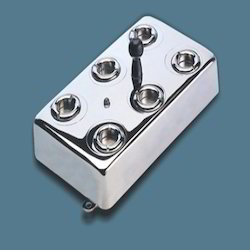Having a definite quality management system, we are regarded as the noteworthy manufacturer, exporter and supplier of an extensive gamut of Ultrasonic Atomizing Transducer. This transducer is designed at our ultra-modern manufacturing unit using the superb quality raw materials and progressive technology in conformance with defined quality standards. Being a quality-oriented organization, we assure our clients that this product is excellent on counts of durability and quality.

An ultrasonic atomizing transducer, also known as an ultrasonic nebulizer or ultrasonic atomizer, is a device that uses ultrasonic vibrations to create a fine mist or aerosol from a liquid. It is commonly used in various applications such as humidifiers, medical inhalers, spray coating systems, and fuel atomization. Here’s how an ultrasonic atomizing transducer typically works:
Transducer Design: An ultrasonic atomizing transducer consists of a piezoelectric element, such as a ceramic disk or plate, which converts electrical energy into mechanical vibrations. The transducer is typically driven by a high-frequency electrical signal, usually in the range of 1 to 3 MHz.
Liquid Reservoir: The transducer is coupled with a liquid reservoir or container that holds the liquid to be atomized. This liquid can be water, a liquid medication, a coating solution, or any other liquid that needs to be transformed into a fine mist.
Ultrasonic Vibration: When the electrical signal is applied to the transducer, it undergoes rapid mechanical vibrations due to the piezoelectric effect. These vibrations are typically in the ultrasonic range, beyond the range of human hearing.
Liquid Dispersion: The ultrasonic vibrations from the transducer create pressure waves in the liquid, causing the formation of tiny droplets or mist. The surface tension of the liquid helps break it up into smaller droplets, which are then dispersed into the surrounding air as a fine mist.
Adjustable Output: The output of the ultrasonic atomizing transducer can often be adjusted to control the size of the generated droplets or mist. By modifying the electrical input signal or adjusting the operating parameters of the transducer, it is possible to achieve different levels of atomization and droplet sizes.
Atomization Efficiency: Ultrasonic atomizing transducers are known for their high atomization efficiency, meaning they can produce a large quantity of fine mist or aerosol from a relatively small amount of liquid. This efficiency is attributed to the intense vibrations and the ability to break up the liquid into tiny droplets.
Non-Heating Process: Unlike some other atomization methods, such as thermal or pressure-based atomization, ultrasonic atomizing transducers operate at room temperature and do not require heating or the introduction of high-pressure air. This non-heating process can be advantageous for applications where temperature-sensitive substances or delicate materials are involved.
Application-specific Considerations: The design and implementation of ultrasonic atomizing transducers can vary depending on the specific application requirements. Factors such as the desired droplet size, flow rate, liquid viscosity, and the targeted application will influence the selection and configuration of the transducer.
Ultrasonic atomizing transducers offer several advantages, including efficient atomization, precise control over droplet size, and the ability to generate a fine mist without the need for heat or high pressure. They find applications in various industries, including healthcare, cosmetics, food processing, agriculture, and industrial manufacturing. When considering the use of an ultrasonic atomizing transducer, it is important to evaluate the compatibility of the transducer with the liquid to be atomized and ensure proper maintenance and cleaning to avoid any clogging or build up.
